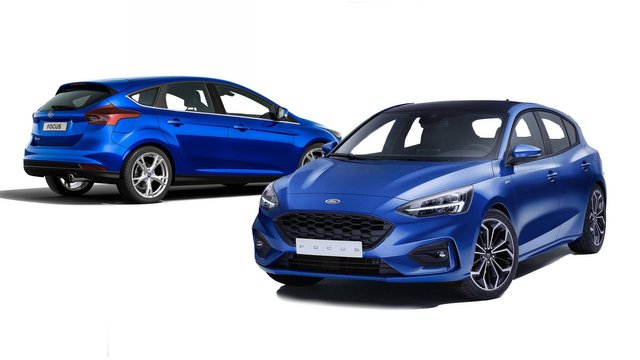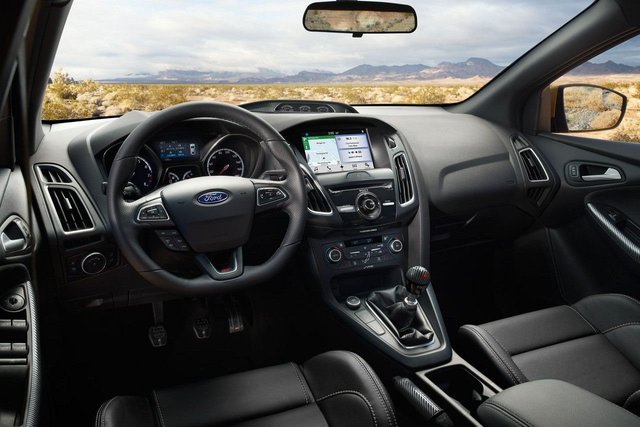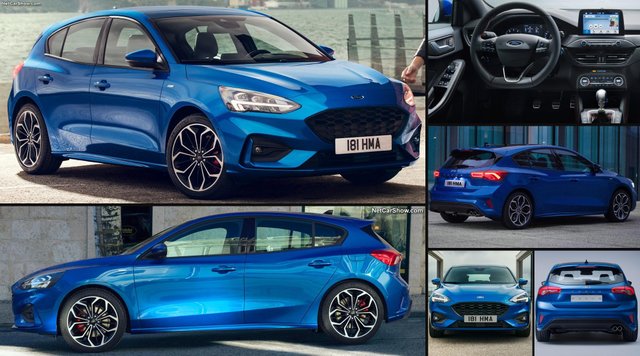The Ford Focus (2019) Review
About the car
The Focus is a chuffing important car for Mr. and MS Car-Buyer here in Britain. The old car, in its final year, was our number three seller, beaten (just) by the Golf and (substantially) by its sibling Fiesta. It’s part of the proof that despite the seemingly unstoppable rise of crossovers, actual hatchbacks still rule. Of the UK’s top 10 in 2017, only one was a crossover, the ant.

The Focus also matters here at Planet Top Gear, because over the years it has been a consistently good drive, as well as throwing up some of our five hot-hatches, under the ST and RS badges.
But the outgoing car, in its mainstream versions, wasn’t one of the greatest-hit Focuses. The bodywork had too many creases, and the driving experience was a little soft-edged. Both these were the result of it being designed for a global audience that included the US (though it didn’t sell well over there). The new one is set up for us Europeans. It won’t be sold Over There.
More cause for optimism: it’s an all-new car. Yes a brand-new platform, engineered to be stiffer for dynamics, safer than ever in a crash, and yet lighter than the old – a reasonable 1,325kg for the three-cylinder manual.
Its profile is sleeker than before, thanks to a longer bonnet with more rear-seat screen pillars, and also to a longer wheelbase. And we think the sheet metal is rather pretty. The wind doesn’t notice it so much: aerodynamic drag Cd is a super-slithery 0.27.
Inside, displays take the form of a tablet for most of the infotainment heavy-lifting, but conventional dials ahead of the driver, and none the worse for that. Also, a £400 flip-up head-up display shows speed, navigation arrows and info on the driver-assist systems, automated systems that are as comprehensive as any car in the class.
You’re not only assisted, you’re also connected. This generation Focus has a built-in SIM so it knows about traffic and can do online destination searches. Plus you can perform various tricks remotely on your car via phone app – finding it, checking fuel, locking and so on. And it gives in-car Wi-Fi.
Given that folk, especially urban folk, are getting wary of diesel, the 1.0-litre Eco boost will sweep up most sales. It’s the heavily revised version from the Fiesta, and comes in 100 and 125bhp, with just 108g/km CO2 even in the strict new WLTP test. Oh yes there’s an 85bhp version in the base-trim, but don’t punish yourself eh?
The bigger petrol engine, a 1.5-litre, is now also a triple, almost the same as the new Fiesta ST jobber. It has 150 or 182bhp. For economy in light use, the three-cylinder engines can close down one of their cylinders.
The 1.5 diesel is all-new and itself full of clever fuel-saving engineering, and should clear legal emissions standards to 2025, they claim. Power is up to 120bhp, and then there’s a revised 2.0-litre diesel making 150bhp.
The auto versions are a conventional eight-speeder, not the old twin-clutch job. They operate via a Jag-style rotary controller to save console space.
There seem to be nearly as many suspensions as there are engines. At the front it’s similar principles as before but all-new parts, with a wider track. Three completely different rear suspensions now turn up according to model.
The hatches with the lowest power now have a torsion-beam setup. Sounds like a retrograde step given it’s the first time we’ve had one of those on a mid-size Ford since the Escort. But a hopeful sign: it’s related to the setup in the new Fiesta ST. It uses banana-shaped springs that push the outer rear wheel outwards as the car rolls in a corner, keeping the trailing arm pointing straight and the wheel better aligned.
Meanwhile, more powerful hatches get a short-and-long arm setup (as the original Focus pioneered). Its advantages are ride quietness and steering precision. Finally, estates get a different layout of SLA system, with the dampers laid near-horizontally, to improve boot space. Top models get the option of adaptive dampers too, for the first time in a mainstream Focus.
Mention of the estate shows that this popular Focus body-style is here at the launch, and it looks pretty sleek but has a properly boxy load space. But as with the last generation there’s no prospect of a three-door hatch.
Never mind: an ST is already well under development and an RS is also highly likely if not any time soon.
Right now a semi-crossover, in the form of a jacked-up Active version (see Fiesta Active for details) is ready for sale. It’s quite possible that some time after launch there will be 4WD versions, because this same new floor pan will also be used for a new Kuga
Driving Experience
The 125bhp three-cylinder is a game little engine, not too leggy even below 2,500rpm, and happy-sounding as it revs to 6,500. So you’ve got a lot of flexibility, even though its best work is in the 3,500-5,500 range. It’s smooth and quiet too.
That’s bolted to a six-speed manual transmission that has a bit of stickiness in its shift, and a rather big gap between second and third. But the clutch and throttle are smooth to use, so it doesn’t get on your nerves.
Cornering is also an entirely sanitary affair. The steering has well-mapped answers to the movement of your hands, and the car steers through any bend with superb reassurance. It simply follows the front wheels, all the way up to the limit.
But it’s a little on the dull side. It doesn’t really leap ahead of the best rivals. This frankly is not what we want from a Ford.
Well there’s an answer. The 1.0 petrol and 1.6 diesel engines get this torsion beam suspension. The 1.5 petrol and 2.0 diesel have the short and long arm suspension. Get into one with that system and you’ll know the difference the first time you turn the wheel a quarter-turn.
The steering’s weight and gearing and progression haven’t changed. But there’s now an immediacy and precision, a sense of connection that wasn’t there in the torsion setup. It’s as if you’ve taken off a thick pair of gloves. Push this Focus, especially the one we tested with the lowered ST-line suspension (the car pictured here), and you can sense its efforts, feel the road, play little games with its angles.
After we’d tested it, the chief engineer told us much of the improvement is due to the ST-Line suspension tuning, not just the SLA suspension. He claims the ST-Line, even with the torsion-beam chassis, also steers very well. Unfortunately there wasn’t a car of that spec to test, so we’ll have to wait and see.
The ST-Line’s extra firmness doesn’t harm the ride. Both suspensions ride tautly, but are brilliant at easing away any sharp edges. The damping too, is terrific, allowing the wheels to breathe over small bumps but keeping the body in check over big crests and dips – especially the ST-Line. We can’t see why you’d need to splash out on adaptive damping. There’s more chassis noise from the torsion-beam setup.
The 1.5, by the way, is a really sweet engine. We tried the 182bhp version, which has slightly less power than when it’s in the Fiesta ST and is quieter with it, but still has the same engaging and sparky nature. Because it’s also just three cylinders, it doesn’t make the car feel nose-heavy.
The 1.5 diesel – we tried the 120bhp - is a decent enough example of a modern diesel engine, delivering the goods over a comparatively broad spectrum of revs. It makes a drumming rather than a rattling sound, but the noise never really goes away, and there’s an annoying resonance at about 2,800rpm.
If you want that SLA suspension (you do) but a 1.0 petrol or 1.5 diesel engine, look at the estates as they all have it.
Sink onto a motorway and the Focus relaxes, the strongly self-centering steering keeping you in line. Might as well turn on the lane assist too (it’s a button on the end of a stalk, so no need to drop your eyes), and it’ll smooth nudge you away from any white-line whooshes. That’s standard on all cars.
The standard emergency auto-braking system is coupled with ‘evasive steering assist’ which nudges the wheel to help you steer in towards an open gap, rather than plough catastrophically into something solid. I didn’t test it. But neither did I get any false positives, which is good.
At the top of the Focus’s assistance tree, the lane-assist system will actually aim to hold the center of the lane and the radar cruise system that operates – in auto box models anyway – from stop-go traffic up to motorway speed. That’s SAE Level 2 automation, if you’re counting. It’s as effective as the system on Volvos and Mercedes.
Active masking for the LED headlights is also available, which don’t only blank the area around oncoming traffic son’s not to dazzle, but also use navigation info to aim around upcoming bends and roundabouts.
Interior Quality
The dash itself, made in a broadly smiling sweep, has been moved forward, to make things feel roomier. Not so far that you can’t reach the touch-screen, mind, which is mounted high up. The significant pieces of its architecture are molded from soft-touch plastic. The door bins are carpet-lined too, to quench rattles, but the actual door-shutting grab handles are a bit hard and scratchy.
( )
)
Because there are now so many electronic systems, Ford has shifted towards touchscreen-and-menu interfaces. But good old’ switches haven’t been consigned entirely to history. The infotainment screen has a set of hard-key shortcuts, the climate control gets proper knobs and buttons, and several of the driving assist systems also get their own quick-access kill-switches. It’s all sensibly laid out and executed with an eye for quality.
Having an electric handbrake gives over useful console space to cup holders, an armrest box and a tray with inductive charging in some versions.
Ford’s Sync operating system for the screen is one that it has been developing nicely over the years. Its graphics are clean enough, but its main advantage is that, having been written for Anglo-Saxon brains, its menus just feel more intuitively logical than ones that started life in German, French or Japanese. It also does Car Play and Android auto in every trim but the bog-basic Style. The screen goes up to eight inches.
The top-end music system is a 675-watter from B&O Play. For the driver, a pretty comprehensive head-up display is also on the options menu.
The front seats are a little flat in the cushion, and don’t have lumbar adjust, but in other ways the driving position is fine.
The longer wheelbase means more room in the back. It’s close to class-leading here. Plus, the new shape of the side glass gives the outer-rear passengers a better view out. And a new center-console shape and flatter rear floor both give the person sat between them more foot space.
The estate has remote-release seat folding and, very handily, a space under the floor to store the roller blind.
ST-Line spec brings slightly better seats, red stitching and a cheery dose of cabin pontification.
Best to regard the Vignola trim as a way to bundle-in lots of tasty technologies that would otherwise be options. The acreage of cabin leather is higher than the other Focuses, but it doesn’t disguise its origins. Is this an Audi A3 where the rest of the range is a Golf? Dream on.
Running Cost
The patrols look like decent value over their lifetime of ownership. Thanks to light weight, low drag and clever engine tech, the turbo 1.0-litre manages just 107g/km. The top one, the 182bhp 1.5-litre, does 0-62mph in 8.3sec, emits 124g/km of CO2 and returns 51.4mpg, which is good going for a petrol.
The corresponding diesels are about 10-15g/km less, so not a compelling advantage.
Ford’s guarantee is three years/60,000miles. Insurance runs from about 11E for low-power style to 20E for higher-power ST-Line and Vignola.
On finance, the various models are a spookily close match for their corresponding VW Golf versions. The most popular will be the 125bhp ST-Line, quoted on PCP at £225/month over 3yrs with a £5,000 initial deposit.
Every Focus gets alloys, air-con and lane keeping assist. Also insurance-friendly autonomous emergency braking that sees pedestrians and cyclists.
Go to the second trim, Zeta, and you’re in for Apple Car play/Android Auto on a 6.5in touchscreen, and cruise. After that you’re into the Titanium levels.
The ST-Line gets a body kit and the tauter suspension. If you don’t like phone mirroring, the ST-Line asks just £350 to step from a 6.5 to 8-inch screen and add built-in satnav. You get that as standard in the ST-Line X, plus power driver’s seat and 18s. Also red brake calipers, which we all know are worth a second a lap.
 ![761608.jpg]
![761608.jpg]
Good keep it up
Upvot my friend
Congratulations @tanuj! You received a personal award!
You can view your badges on your Steem Board and compare to others on the Steem Ranking
Do not miss the last post from @steemitboard:
Vote for @Steemitboard as a witness to get one more award and increased upvotes!